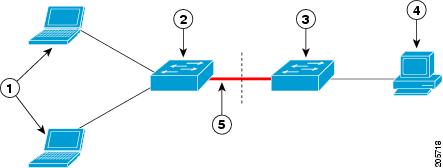802.1x Supplicant and Authenticator Switches with Network Edge Access Topology
The 802.1x standard defines a client-server-based access control and authentication protocol that prevents unauthorized clients from connecting to a LAN through publicly accessible ports unless they are properly authenticated. The authentication server authenticates each client connected to a switch port before making available any services offered by the switch or the LAN. For more information about 802.1x, including configuration information, see Configuring IEEE 802.1x Port-Based Authentication.
The Network Edge Access Topology (NEAT) feature extends identity to areas outside the wiring closet. This allows any type of device to authenticate on the port. NEAT uses Client Information Signalling Protocol (CISP) to propagate Client MAC and VLAN information between supplicant and Authenticator. CISP and NEAT are supported only on L2 ports, not on L3 ports. You can configure NEAT on Cisco Catalyst IE9300 Rugged Series Switches.
-
802.1x switch supplicant: You can configure a switch to act as a supplicant to another switch by using the 802.1x supplicant feature. This configuration is helpful in a scenario, where, for example, a switch is outside a wiring closet and is connected to an upstream switch through a trunk port. A switch configured with the 802.1x switch supplicant feature authenticates with the upstream switch for secure connectivity. Once the supplicant switch authenticates successfully the port mode changes from access to trunk in an authenticator switch. In a supplicant switch you must manually configure the trunk when enabling CISP.
-
If the access VLAN is configured on the authenticator switch, it becomes the native VLAN for the trunk port after successful authentication.
In the default state, when you connect a supplicant switch to an authenticator switch that has BPDU guard enabled, the authenticator port could be error-disabled if it receives a Spanning Tree Protocol (STP) bridge protocol data unit (BPDU) packets before the supplicant switch has authenticated. You can control traffic exiting the supplicant port during the authentication period. Entering the dot1x supplicant controlled transient global configuration command temporarily blocks the supplicant port during authentication to ensure that the authenticator port does not shut down before authentication completes. If authentication fails, the supplicant port opens. Entering the no dot1x supplicant controlled transient global configuration command opens the supplicant port during the authentication period. This is the default behavior.
We strongly recommend using the dot1x supplicant controlled transientcommand on a supplicant switch when BPDU guard is enabled on the authenticator switch port with the spanning-tree bpduguard enable interface configuration command.
 Note |
If you globally enable BPDU guard on the authenticator switch by using the spanning-tree portfast bpduguard default global configuration command, entering the dot1x supplicant controlled transient command on the Supplicant switch does not prevent the BPDU violation. |
You can enable MDA or multiauth mode on the authenticator switch interface that connects to one more supplicant switches. Multihost mode is not supported on the authenticator switch interface.
When you reboot an authenticator switch with single-host mode enabled on the interface, the interface may move to err-disabled state before authentication. To recover from err-disabled state, flap the authenticator port to activate the interface again and initiate authentication.
Use the dot1x supplicant force-multicast global configuration command on the supplicant switch for NEAT to work in all host modes.
-
Host Authorization: Ensures that only traffic from authorized hosts (connecting to the switch with supplicant) is allowed on the network. The switches use CISP to send the MAC addresses connecting to the supplicant switch to the authenticator switch.
-
Auto enablement: Automatically enables trunk configuration on the authenticator switch, allowing user traffic from multiple VLANs coming from supplicant switches. Configure the cisco-av-pair as device-traffic-class=switch at the ISE. (You can configure this under the group or the user settings.)
Figure 1. Authenticator and Supplicant Switch Using CISP 
|
1 |
Workstations (clients) |
|
2 |
Supplicant switch (outside wiring closet) |
|
3 |
Authenticator switch |
|
4 |
Cisco ISE |
|
5 |
Trunk port |
 Note |
The switchport nonegotiate command is not supported on supplicant and authenticator switches with NEAT. This command should not be configured at the supplicant side of the topology. If configured on the authenticator side, the internal macros will automatically remove this command from the port. |
 Feedback
Feedback